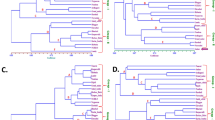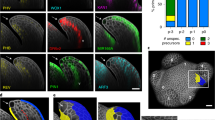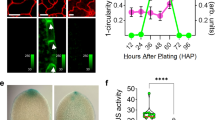Abstract
THE ovary of an edible banana, Musa paradisiacaLinn., develops into a vegetatively parthenocarpic fruit and at maturity is filled with starchy parenchy-matous tissues. Simmonds1 reported the autonomous production of auxin, suspected as being indolyl-3-acetic acid (IAA), in the young ovaries of banana. The presence of ‘coconut milk factor’ in the banana ovaries has also been reported2,3. The results reported here are from investigations carried out in this laboratory during 1960–61 on the type of auxin and amino-acids present in the ovaries of banana.
This is a preview of subscription content, access via your institution
Access options
Subscribe to this journal
Receive 51 print issues and online access
$199.00 per year
only $3.90 per issue
Buy this article
- Purchase on SpringerLink
- Instant access to full article PDF
Prices may be subject to local taxes which are calculated during checkout
Similar content being viewed by others
References
Simmonds, N. W., J. Exp. Bot., 4, 87 (1953).
Steward, F. C., and Simmonds, N. W., Nature, 173, 1083 (1956).
Nichols, R., Nature, 181, 919 (1958).
Wright, S. T. C., J. Hort. Sci., 31, 196 (1956).
Sen, S. P., and Leopold, A. C., Physiol. Plantarum, 7, 98 (1954).
Jones, E. R. H., Henbest, H. B., Smith, G. F., and Bentley, J. A., Nature, 169, 487 (1952).
Giri, K. V., and Rao, N. A. N., J. Ind. Inst. Sci., 35, 343 (1953).
Simmonds, N. W., Ann. Bot., 24, 94 (1960).
Author information
Authors and Affiliations
Rights and permissions
About this article
Cite this article
SHANMUGAVELU, K., RANGASWAMI, G. Tryptophan and Indole Compounds in Banana Ovaries. Nature 194, 775–776 (1962). https://doi.org/10.1038/194775a0
Issue date:
DOI: https://doi.org/10.1038/194775a0
This article is cited by
-
Zur Verbreitung von Glucobrassicin und Neoglucobrassicin in höheren Pflanzen
Experientia (1965)



